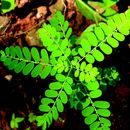en
names in breadcrumbs


Phyllanthus amarus is a leafy herbal plant found in tropical regions in the Americas, Africa, India, China and South East Asia. Commons names for this plant include gale of the wind, carry me seed, seed on the leaf, pick-a-back,[1] Bhuiavla (Hindi), Bhuiamla (Bengali),[2] stonebreaker, dukung anak (Malay).[3]
P. amarus is a small, annual plant that grows to a height of 30-60 cm. Its thin branches spread out, and each branch has two rows of small, elliptic-oblong leaves of 5-10mm long that are arranged alternately.[3] Its radial flowers are star-shaped and of about 2mm in size.[4] It grows well in soil of high moisture with light shade, and reaches maturity in 2-3 months.
P. amarus contains flavonoids (quercetin-3-0-glucoside and ruin), tannins (geraniin, amariin and gallocatechin) and alkaloids (phyllantine, quinolizidine type, securinine, norsecurinine, isobubbialine and epibubbialine).[3]
P. amarus has been used in the traditional medicine of various cultures, including Amazonian tribes for the treatment of gallstones and kidney stones; in Ayurvedic medicine for bronchitis, anaemia, diabetes; and in Malay traditional medicine for diarrhoea, kidney ailments and gonorrhea.[3] More recently there have been preclinical and clinical studies looking into the plant's supposed liver-protective abilities[5][6] and effect on hepatitis B.[7]
According to animal tests, it has hepatic protection against paracetamol hepatoxicity in rats.[8]
Phyllanthus amarus is a leafy herbal plant found in tropical regions in the Americas, Africa, India, China and South East Asia. Commons names for this plant include gale of the wind, carry me seed, seed on the leaf, pick-a-back, Bhuiavla (Hindi), Bhuiamla (Bengali), stonebreaker, dukung anak (Malay).
Chó đẻ thân xanh hay diệp hạ châu thân xanh (danh pháp hai phần: Phyllanthus amarus) là một loài thực vật có hoa trong họ Diệp hạ châu. Loài này được Schumach. & Thonn. mô tả khoa học đầu tiên năm 1829.[1]
Chó đẻ thân xanh hay diệp hạ châu thân xanh (danh pháp hai phần: Phyllanthus amarus) là một loài thực vật có hoa trong họ Diệp hạ châu. Loài này được Schumach. & Thonn. mô tả khoa học đầu tiên năm 1829.
小返魂(学名:Phyllanthus amarus)为大戟科油柑属下的一个种。
抵抗發炎、細菌以及病毒感染,可當作利尿劑,對腎結石、膽結石、傷風、流行性感冒、消化作用、氣喘、支氣管炎、腹瀉、減輕痛苦、發燒及傳染性性病以及肌肉抽筋等有益處。
|access-date=中的日期值 (帮助)